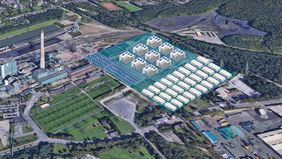
Green hydrogen project in Duisburg-Walsum seeking IPCEI funding
Duisburg/Dortmund/Essen. thyssenkrupp Steel Europe, thyssenkrupp Uhde Chlorine Engineers and STEAG plan to build and operate a 500 megawatt (MW) hydrogen electrolysis plant to decarbonize steel production in Duisburg. The partners are now jointly seeking recognition of the project as an "Important Project of Common European Interest" (IPCEI) and related investment aid from federal and state funds.
With the declared intention of producing climate-friendly green hydrogen to decarbonize thyssenkrupp’s steel production in Duisburg using electrolysis based on green power, the “HydrOxy Hub Walsum” project will provide key impetus in enabling climate-neutral steel production throughout Europe on an industrial scale in the medium and long term based on the knowledge gained in Duisburg – and will thus also be instrumental in maintaining competitiveness in the long term. “In this sense, the planned 500 MW electrolysis facility in Duisburg, the largest steel location in the EU, is indisputably an important project of common European interest – in short, an IPCEI,” explains Dr. Ralf Schiele, who is responsible within the STEAG management for the Market and Technology divisions.
In line with German and European hydrogen strategy
The fact that hydrogen will play an important role in the success of the energy transition and the gradual decarbonization of industry and parts of the mobility sector due to its wide range of possible applications has now also been reflected in detailed hydrogen strategies drawn up by the German government and the European Union (EU).
The thyssenkrupp and STEAG project in Duisburg-Walsum takes full account of both the objectives of the German federal government and the EU's hydrogen strategy. In addition, successful implementation of the project will contribute directly to achieving the targets set out in the Federal Climate Change Act for the gradual reduction of greenhouse gases, in that it will enable CO2 emissions to be avoided on a significant scale and on a permanent basis in the future.
IPCEI funding a key component in the investment decision
“The “HydrOxy Hub Walsum” project conforms to a high degree with the politically defined objectives for the climate-friendly transformation of the European economies, and so we are optimistic about the application process,” says Ralf Schiele. Awarding of the project in the IPCEI selection process would inasmuch amount to an initial but material component in any subsequent investment decision.
As Kevin Galle, “HydrOxy Hub Walsum” Project Manager at STEAG points out, the project partners are fundamentally open to the involvement of further investors: “The possible classification of the project as an eligible IPCEI project would document not only its relevance to society as a whole, but also important political backing, which in turn can act as a signal to private investors to help implement this key industry and energy project.”
Implementation of the project not dependent on IPCEI funding alone
Nevertheless, the implementation of the project is not solely linked to its funding as an IPCEI. On the contrary: “Irrespective of the outcome of the proceedings, the project partners are continuing to press ahead with the feasibility study for the project,” Kevin Galle reports. “This provides the basis for the rapid implementation of a beacon project in the energy and industrial transition, thus securing qualified industrial jobs.”
Ideal location enables near-term implementation
What also sets the “HydrOxy Hub Walsum” project apart is the close proximity of the production and consumption of green hydrogen, meaning that it is not dependent on the construction of a supply system specifically designed for the transport of hydrogen and can thus be implemented quickly. The current plan is for the electrolysis facility to be connected to the grid and producing green hydrogen as early as 2025. With these additional circumstances also in its favor, the project is predestined to be a major backbone of the future hydrogen economy in Germany and the EU at the interface between industrial production and urban living environments.
